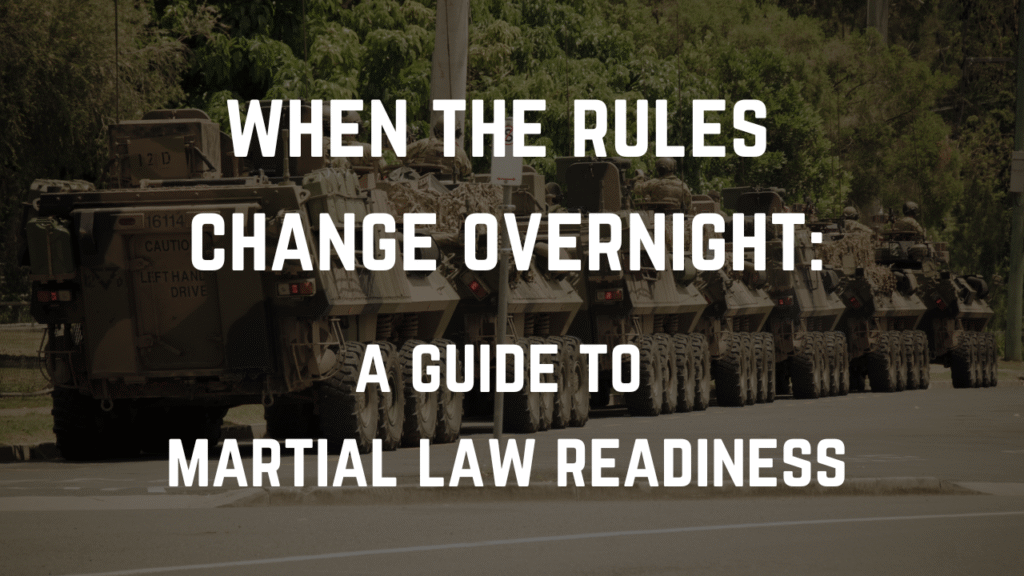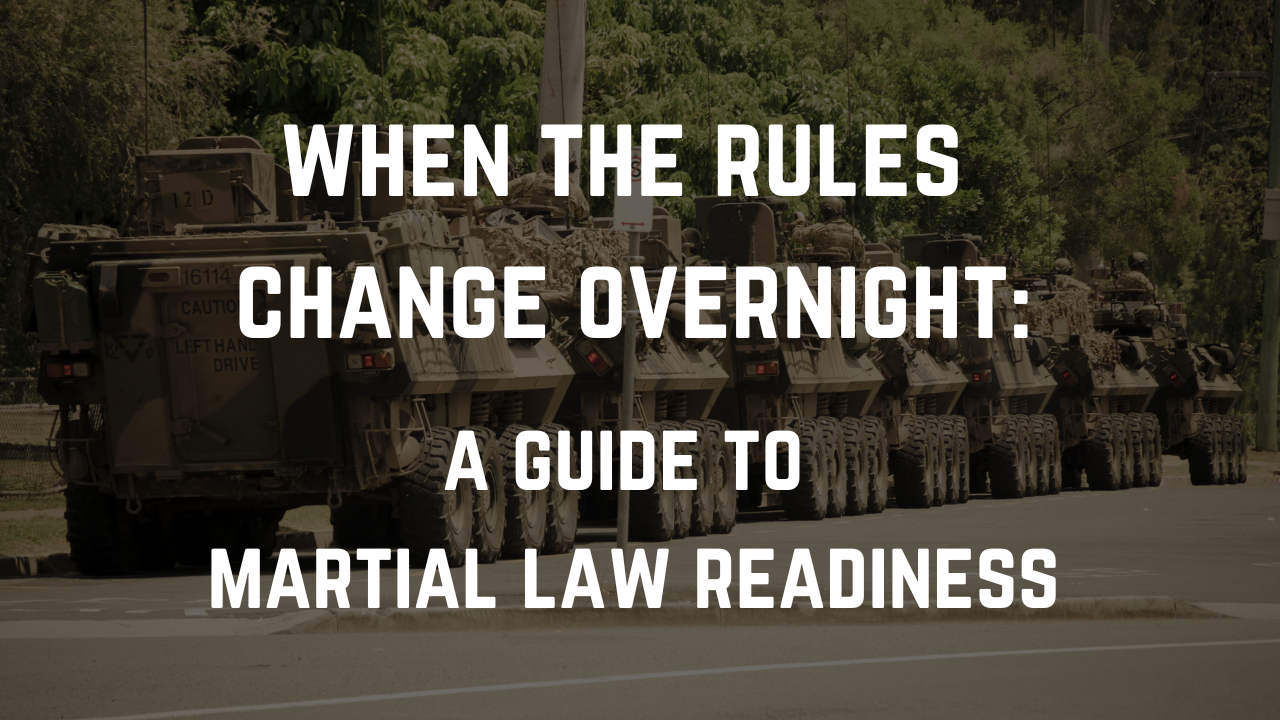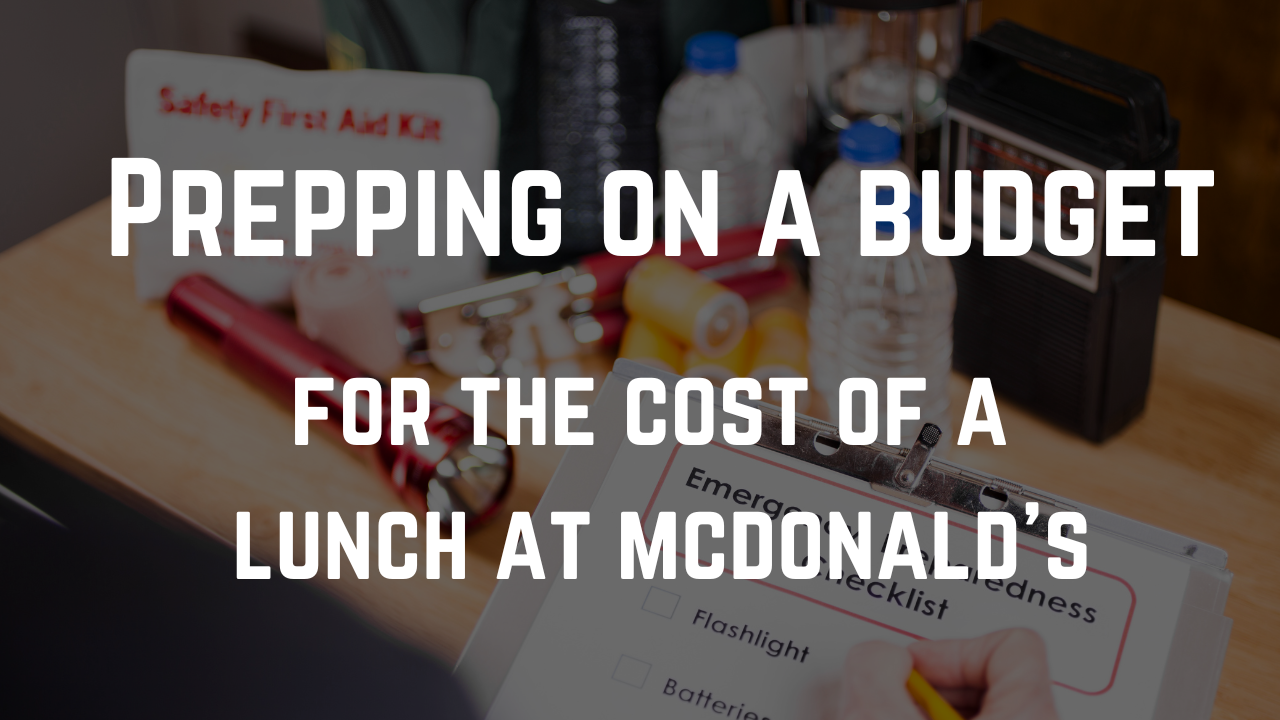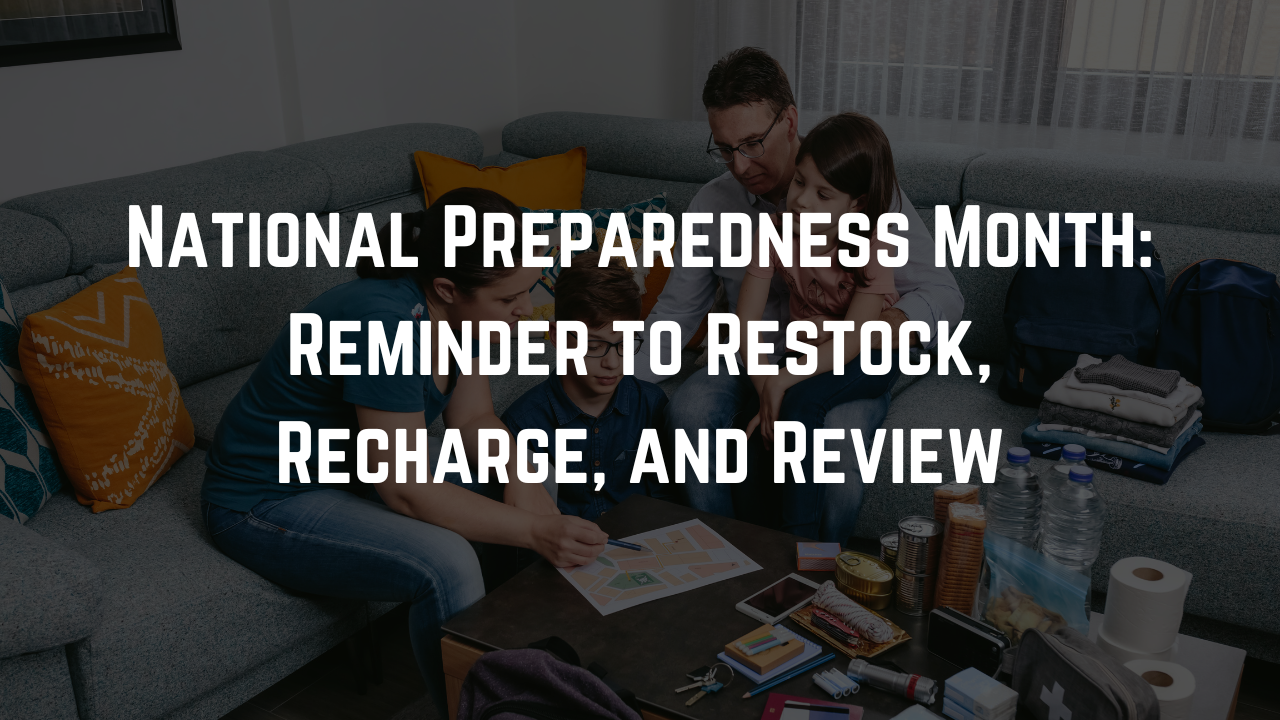
When the Rules Change Overnight: A Guide to Martial Law Readiness
When Martial Law Becomes More Than a Thought Experiment
“Martial law” often evokes dramatic images of soldiers patrolling city streets, curfews, and a sudden suspension of everyday liberties. But what if the conditions that make martial law a possibility begin unfolding in plain sight?
In a world filled with rapid social change, technological disruptions, natural catastrophes, and political polarization, the possibility of martial law may feel less like a fringe scenario and more like a stress test for how communities and individuals respond when the system strains.
Let’s walk through the warning signs, the preparatory steps, and a survival-minded mindset for when the extraordinary becomes our lived reality.
Spotting the Red Flags: When to Raise Your Mental “Yellow Alert”
It’s not enough to wait until soldiers are at your front door. Being attentive to early signals gives you a chance to act with forethought, not panic.
If three or more of the following start happening, particularly in your area, you should treat that as a “yellow alert.”
Some of the most noticeable warning signs include:
- Rapid escalation of civil unrest. Multiple cities, more intense confrontations, widespread protest activity.
- Breakdown or bypassing of local government. Authorities openly saying they can’t maintain order, courts delaying or suspending operations, emergency powers granted to executives.
- Large-scale disasters or infrastructure failure. Think major blackouts, communications failure, widespread disease outbreaks.
- Military presence in civilian areas. Armored vehicles, checkpoints, troops on city streets for reasons that aren’t clearly explained.
- Snap changes in laws or executive orders. Curfews, travel bans, restrictions on gatherings — sometimes ambiguous or open-ended.
- Government messaging shifts. Cautionary language about “extraordinary measures,” censorship or news suppression, heavy-handed official statements.
- Administrative “clean-up” moves. Suddenly locked doors at public buildings, new ID checks, closures for “security reasons.”
If you see multiple signals stacking up in your region, it’s time to quietly move your preparedness posture from latent to active.
Proactive Steps: From Readiness to Resilience
Once you decide it’s time to act, the goal is to build flexibility, protect what matters, and avoid drawing unnecessary attention. Here’s a roadmap:
1. Understand Your Rights Before They’re Tested
- Study constitutional protections especially those relevant to searches, detentions, movement, and assembly.
- Know what rights can and can’t be properly suspended.
- Keep a printed, portable “know your rights” reference. There may be times when online access is limited. Download ours here.
2. Top Off and Diversify Essential Supplies
- Food & Water: Aim for 2–4 weeks of shelf-stable food. Have filtration or purification options for water.
- Medications & First Aid: Refill prescriptions early. Store over-the-counter medicines and a first aid kit.
- Fuel & Power: Maintain your primary fuel sources and have backup options (if safely and legally viable).
- Energy & Lighting: Batteries, solar chargers, lanterns, and redundancy matter.
3. Secure Documents & Records
- Collect IDs, passports, insurance papers, medical records, proof of property ownership, etc.
- Store them in waterproof, fireproof containers.
- Make both physical and encrypted digital backups, ideally stored in separate locations.
4. Strengthen (But Limit) Communication Channels
- Define a primary and backup communication plan (cell, radio, encrypted apps).
- Use tools like Zello (walkie-talkie style) or other mesh / peer-to-peer options if internet connectivity is unstable.
- Share the plan selectively – only with the people you trust implicitly.
5. Handle Cash & Financial Readiness
- Withdraw a modest amount of cash in small bills. ATMs may suddenly go offline.
- Make advance payments for essential services (rent, utilities) if possible.
- Diversify where your savings are held (not just in digital, centralized systems).
6. Keep a Low Profile
- Don’t flaunt your stockpile. Avoid social media posts about “prepping,” supplies, or movement.
- Use inconspicuous containers for supply runs and deliveries.
- Minimize unnecessary travel or patterns that might draw surveillance.
7. Monitor Information Wisely
- Follow multiple credible news sources and official government channels.
- Be skeptical of rumors or sensationalist reports. Panic often travels faster than facts.
- Cross-check with regional data and direct announcements.
8. Prepare Your Home & Shelter Strategy
- Reinforce basic physical security: locks, lighting, secure windows.
- Position essentials (flashlights, batteries, bedding) so they’re quickly accessible.
- Spread your critical supplies throughout multiple hiding places. Don’t keep everything in one spot.
- Moderate use of lighting, noise, or power systems so you don’t draw unwanted attention.
- Plan potential shelter options (safe houses, alternate sites) and keep route maps (paper + compass) ready.
9. Practice Calm, Consistent Behavior
- Keep all interactions calm and minimal. Be polite and respectful with military or law enforcement. Arguing on the spot rarely works in your favor.
- Everyone in your home should know what to say if questioned (“I don’t know” is sometimes safer than over-explaining).
- Make sure kids know not to talk about supplies or plans.
- Comply with lawful orders, but document incidents privately if you believe your rights were violated.
- Avoid heated political conversations in public or online.
When Martial Law Is Declared: How to Operate Under Conditions of Constraint
Should martial law be formally declared, your survival strategy shifts toward minimizing exposure, adhering to minimal compliance, and preserving your ability to adapt.
- Carry official ID, always. Even short trips may require it. Keep a backup stored securely.
- Blend in. Avoid wearing gear or clothing that screams “prepped” or militant. Use non-descript bags and minimize signals of distinction.
- Have a plausible “cover story.” If asked why you’re moving, have a simple, reasonable explanation (medicine, family, work). Avoid giving extra detail.
- Comply where possible, document where needed. Don’t unnecessarily resist an order unless it clearly violates un-suspendable rights, but record what happens so you can pursue accountability later.
- Limit what you disclose. Avoid discussing supply caches, plans, or alliances in public or even semi-private conversations.
- Be ready to relocate if necessary. If your immediate location becomes unsafe, having alternate shelter and travel plans can save you.
Preparing the Mindset: Flexibility, Resilience & Community
No plan survives first contact entirely intact. Your greatest leverage is your adaptability, your ability to keep calm under pressure, and your capacity to connect meaningfully (and discreetly) with trustworthy allies.
- Practice scenario drills. Run through “what if” situations occasionally so that instincts, not panic, guide you.
- Stay physically and mentally fit. Hard situations amplify weakness.
- Foster relationships in your local community. While trust must be earned, local support networks can offer resilience.
- Stay humble. You won’t “beat” martial law with machismo. Quietness, stealth, and discretion often carry more value than visibility.
Strength Through Readiness
Martial law may still feel extreme or unlikely to many, but preparing for extreme scenarios is not about paranoia; it’s about readiness in an age where disruptions proliferate.
By staying alert to warning signs, quietly securing what matters, and adopting a mindset rooted in resilience rather than fear, you preserve your options when the system tenses.


